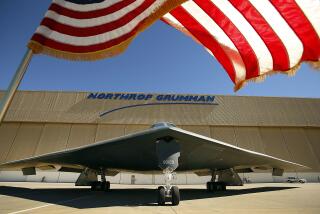Pentagon Moves Ahead With Plan to Close Down C-17 Production
Pentagon officials have begun the formal process to end Boeing Co.’s production of C-17 cargo jets in Long Beach by 2008, despite congressional lobbying to keep the assembly line open.
In a classified Pentagon budget request last week, Deputy Defense Secretary Gordon England officially asked for $265 million in next year’s budget to mothball the tools and machinery used to produce the four-engine cargo jets.
The Pentagon move advances an Air Force decision last fall to buy no more C-17s beyond the 180 it already has acquired or has on order, setting in motion a shutdown of California’s last major airplane manufacturing plant. The final C-17 is scheduled for delivery in late 2008.
About 7,000 people work at the Boeing assembly plant next to the Long Beach Airport. An additional 500 firms that employ 5,000 people in Southern California make parts for the C-17. The Air Force has taken delivery of 141 of the C-17s from Boeing since 1995. About 15 aircraft a year roll off the assembly line. Additionally, four of the planes have been built for the British Royal Air Force.
The C-17, nicknamed the Globemaster III, has been a workhorse in transporting military personnel and heavy equipment in the war zones in Iraq and Afghanistan. The Air Force also used C-17s to deliver food and medical supplies throughout the Gulf Coast region after hurricanes Katrina and Rita.
But with the Pentagon facing a budget crunch, several aerospace analysts said, the agency was unlikely to alter its C-17 plans unless Congress earmarks separate funding for the plane.
The final decision on the C-17 rests with Defense Secretary Donald H. Rumsfeld, who has not publicly commented on his plans. The Bush administration will present its fiscal 2007 defense budget to Congress next month.
The C-17 plant is one of two airplane manufacturing lines left in Southern California, once the nation’s bastion of aircraft production. The other factory, also in Long Beach, will close this spring after Boeing delivers the last of its 717 commercial jets.
Rick Sanford, a spokesman for Chicago-based Boeing, said the company had not seen the latest Pentagon memo, but he noted, “We remain hopeful that the Pentagon will continue the C-17 program.”
The Defense Department move surprised C-17 supporters in Congress, who had hoped to sway the White House before a final decision was made.
Some aerospace analysts questioned whether California’s congressional delegation had sufficient clout to be able to persuade other members of Congress to set aside billions of dollars for the C-17 program. Each Globemaster III costs about $175 million.
“Unfortunately, the California delegation doesn’t have a good reputation for supporting defense programs,” said Loren Thompson, a defense policy analyst for the Lexington Institute. “If one of its two senators doesn’t put a lot of energy behind this program, it’s dead.”
But some congressional staffers said the California delegation had banded together in its C-17 lobbying effort and still hoped to persuade Congress to fund the program because the plane also had been used for medical and humanitarian missions.
In an e-mail Friday, Sen. Dianne Feinstein (D-Calif.) vowed to fight for the Globemaster III: “I will continue to work closely with my colleagues in Congress to ensure that the C-17 program receives the funding necessary.”
Last month, 148 House members and 13 senators asked President Bush to order more C-17s. That followed passage of a Senate amendment that urged the Air Force to acquire 42 more of the aircraft.
“Clearly, there is a will in Congress to keep the [assembly] line open,” said John N. Young, legislative director for Rep. Juanita Millender-McDonald (D-Carson), who is spearheading the lobbying effort in the House.
But the survival of the C-17 may depend on a separate program to refurbish and upgrade the Air Force’s aging fleet of C-5 Galaxy cargo jets, analysts said. The C-5s were built by Lockheed Martin Corp., and the last plane was delivered in 1989.
Air Force officials have privately told aerospace executives that one reason the military can’t buy more C-17s is because of a congressional directive mandating that the Air Force continue to operate its oldest C-5s. The Galaxy first entered service in 1970.
The Air Force initially said it needed a fleet of 222 C-17s to meet military airlift requirements. But a recent Pentagon study said 180 planes would be sufficient because the Air Force also planned to keep 126 C-5s in operation.
The Air Force expects to spend about $12 billion refurbishing C-5s over the next decade or two. But C-17 proponents have contended that the money would be better spent to buy the newer, more reliable Globemaster III.
The fate of the C-17 may come down to “horse-trading” in Congress, not at the Pentagon, Thompson said.
More to Read
Inside the business of entertainment
The Wide Shot brings you news, analysis and insights on everything from streaming wars to production — and what it all means for the future.
You may occasionally receive promotional content from the Los Angeles Times.








